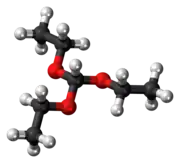Triethyl orthoformate
Triethyl orthoformate is an organic compound with the formula HC(OC2H5)3. This colorless volatile liquid, the orthoester of formic acid, is commercially available. The industrial synthesis is from hydrogen cyanide and ethanol.[1]
 | |
 | |
| Names | |
|---|---|
| Preferred IUPAC name
(Diethoxymethoxy)ethane | |
| Other names
Triethoxymethane; Ethyl orthoformate | |
| Identifiers | |
3D model (JSmol) |
|
| ChEMBL | |
| ChemSpider | |
| ECHA InfoCard | 100.004.138 |
| EC Number |
|
PubChem CID |
|
| UNII | |
| UN number | 2524 |
CompTox Dashboard (EPA) |
|
| |
| |
| Properties | |
| C7H16O3 | |
| Molar mass | 148.202 g·mol−1 |
| Density | 0.891 g/mL |
| Melting point | −76 °C (−105 °F; 197 K) |
| Boiling point | 146 °C (295 °F; 419 K) |
| Hazards | |
| GHS labelling: | |
  | |
| Warning | |
| H226, H315, H319, H335 | |
| P210, P233, P240, P241, P242, P243, P261, P264, P271, P280, P302+P352, P303+P361+P353, P304+P340, P305+P351+P338, P312, P321, P332+P313, P337+P313, P362, P370+P378, P403+P233, P403+P235, P405, P501 | |
| Safety data sheet (SDS) | Fischer Scientific |
Except where otherwise noted, data are given for materials in their standard state (at 25 °C [77 °F], 100 kPa).
Infobox references | |
It may also be prepared from the reaction of sodium ethoxide, formed in-situ from sodium and absolute ethanol, and chloroform:[2]
- CHCl3 + 3 Na + 3 EtOH → HC(OEt)3 + 3⁄2 H2 + 3 NaCl
Triethyl orthoformate is used in the Bodroux-Chichibabin aldehyde synthesis, for example:[3]
- RMgBr + HC(OC2H5)3 → RC(H)(OC2H5)2 + MgBr(OC2H5)
- RC(H)(OC2H5)2 + H2O → RCHO + 2 C2H5OH
In coordination chemistry, it is used to convert metal aquo complexes to the corresponding ethanol complexes:[4]
- [Ni(H2O)6](BF4)2 + 6 HC(OC2H5)3 → [Ni(C2H5OH)6](BF4)2 + 6 HC(O)(OC2H5) + 6 HOC2H5
Triethyl orthoformate (TEOF) is an excellent reagent for converting compatible carboxylic acids to ethyl esters. Such carboxylic acids, refluxed neat in excess TEOF until low-boilers cease evolution, are quantitatively converted to the ethyl esters, without need for extraneous catalysis.[5] Alternatively, added to ordinary esterifications using catalytic acid and ethanol, TEOF helps drive esterification to completion by converting the byproduct water formed to ethanol and ethyl formate.
See also
References
- Ashford's Dictionary of Industrial Chemicals, Third edition, 2011, page 9288
- W. E. Kaufmann and E. E. Dreger (1941). "Ethyl orthoformate". Organic Syntheses.; Collective Volume, vol. 1, p. 258
- G. Bryant Bachman (1943). "n-Hexaldehyde". Organic Syntheses.; Collective Volume, vol. 2, p. 323
- Willem L. Driessen, Jan Reedijk "Solid Solvates: The Use of Weak Ligands in Coordination Chemistry" Inorg. Synth., 1992, Vol. 29,111–118. doi:10.1002/9780470132609.ch27
- Paine, John B. (July 2008). "Esters of Pyromellitic Acid. Part I. Esters of Achiral Alcohols: Regioselective Synthesis of Partial and Mixed Pyromellitate Esters, Mechanism of Transesterification in the Quantitative Esterification of the Pyromellitate System Using Orthoformate Esters, and a Facile Synthesis of the Ortho Pyromellitate Diester Substitution Pattern". The Journal of Organic Chemistry. 73 (13): 4929–4938. doi:10.1021/jo800543w. ISSN 0022-3263. PMID 18522420.